Rising Up: Depictions of Social Protest in Comics
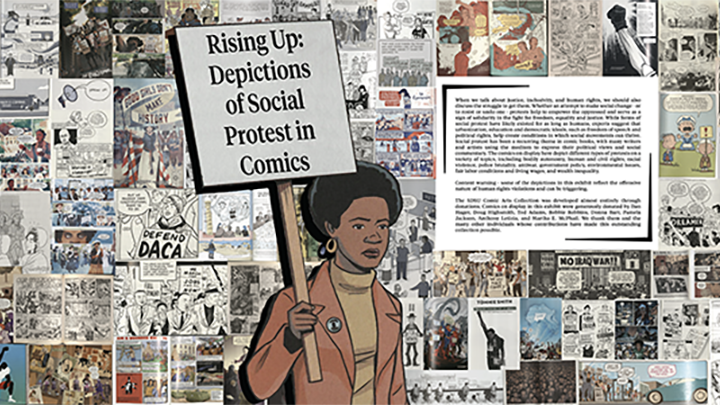
The San Diego State University Library and the Center for Comics Studies are excited to unveil their newest exhibit: Rising Up: Depictions of Social Protest in Comics. The exhibit features depictions of social justice protests in comics and graphic novels, along with wallpaper displays commenting on civil rights issues and encouraging voting. Visitors can also create their own miniature protest signs and either take them home or leave them for others to enjoy. The exhibit will be in place through 2024 in the Special Collections area (first floor of Love Library) and available during library hours. The exhibit is adjacent to the Comics Corner, where visitors can peruse a selection of comics as well as a variety of scholarly works in Comics Studies.
Popular Culture Librarian and Center for Comics Studies Co-Director Pamela Jackson has been formulating this exhibit for more than a year and is thrilled to feature it during this election year. “Protests and struggles for social progress have really ramped up again in recent years. We see protests in the news constantly. It’s my hope that the students - our main audience - will learn more about our long history of meaningful protest as a powerful way to lobby for social change, and that they are also drawn to participate in broader civic action.”
Center for Comics Studies Co-Director and Distinguished Professor of History Elizabeth Pollard noted that, “this exhibit is central to the mission of the Comics and Social Justice President's Big Idea and that not only will our students here at SDSU benefit from seeing how comics can advocate for social justice but also teachers in our Summer Institute for K-12 teachers will be able to take back to their students nationwide the lessons that they learn about 'Rising Up.'"
Jackson says, “Comics are a powerful way to address social justice issues. Because they present information in both text and graphics, they have a special power to bring issues to life. Visual representations help people develop empathy and compassion, and may aid in developing a deeper understanding of the issues. And that understanding sticks with people.”
The exhibit features seven themed cases of comics, each marked with a miniature protest sign.
Case 1: Respect Existence or Expect Resistance!
“Protests in support of Civil Rights and equality are plentiful. Whether centered on racial equality, women’s rights, disabled justice, 2SLGBTQIA+ rights, immigration, incarcerated people, or an intersection of identities, comics frequently depict the historical struggle for treating all humans as worthy of equal rights and respect.”
This case features many examples of general civil rights protests, both historical and contemporary, fact and fiction.
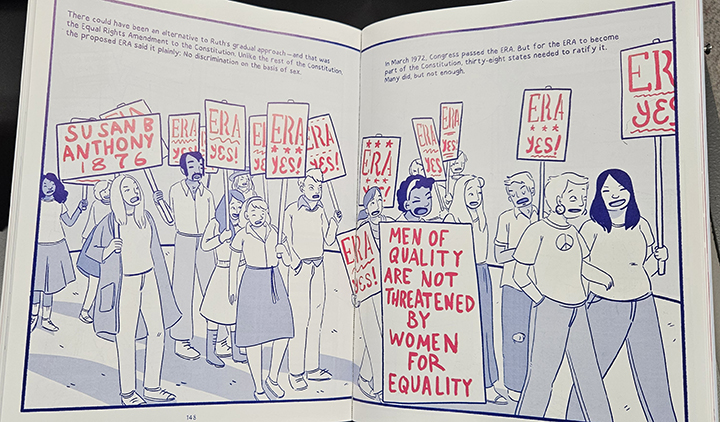
Case 2: Hungry? Eat the Rich!
“In what’s being called historical levels of disparity by financial experts, income inequality in the U.S. is one of the highest among rich countries. The top 10% of Americans own more than 70% of the country’s wealth. Globally, billionaires and multimillionaires are on the rise while the middle class shrinks, the bottom 50% slips deeper into poverty, and the average retirement age increases. Income and wealth have direct impacts on politics, the environment, gender equity and social justice. As the World Inequality Report states, ‘Inequality is a political choice, not an inevitability.’ “
This case features protests centered on issues of wealth and inequality, including one where the super heroes protest for the right to work (i.e. use their super powers).
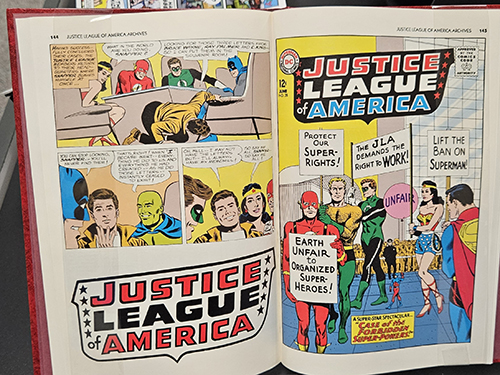
Case 3: My Body My Choice
“Although they outnumber men in the United States, women continue to struggle and fight for equal rights, equal pay and governance over their own bodies. While some comics chronicle women’s suffrage movements during the first-wave of feminism, many modern comics dive into defiant acts of second-wave feminism during the 1960s-70s and female empowerment movements that continue today.“
Case 3 looks at the topic of bodily autonomy, including trans rights, a crocheted pussy hat by cartoonist Donna Barr, and comics that were created as fundraisers for Planned Parenthood.
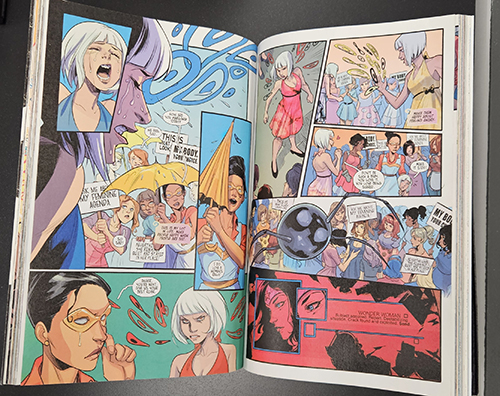
Case 4: She Was Sleeping
“The Civil Rights Movement did not end systemic racism. People of color are disproportionately impacted by police brutality, racial violence, and sentencing inequities in the criminal justice system.”
This case delves into the protests of Black Lives Matter and police violence, including a French comic depicting similar protests in France.
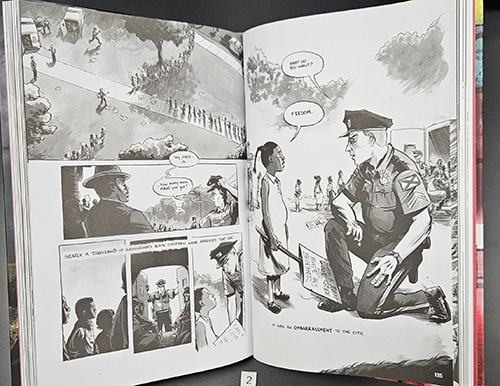
Case 5: Power to the People
“A healthy democracy allows for the freedom of speech and criticism of one's own government. Whether it’s anti-war, anti-Capitalism, anti-policy, or for or against social progress, protests have long sought to hold the government accountable to serving the will of the people. Non-fiction and historical fiction comics based on true events are plentiful.”
The fifth case looks at protests directed toward governmental policies, as well counter-protests to social progress.
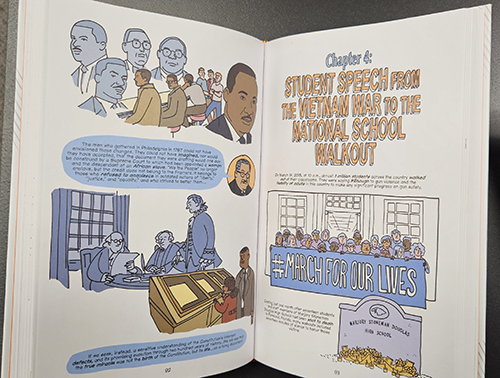
Case 6: Sounds of Silence
"‘Make your voices heard!’ can also be a metaphorical call to action. Some acts of social protest are silent acts or speak volumes in gestures alone. Some acts may be forms of civil disobedience and nonviolent resistance that are not always viewed as social protest, but can be given the context in which the act was performed. Silent marches, sit-ins, kneeling, first raising, boycotts, symbols, and yes, even giving the Presidential motorcade the middle finger salute are forms of silent protest.”
Protests without words or signs are featured in the sixth case.

Case 7: Keep the Earth Clean. It’s Not Uranus
“Rising temperatures, erratic weather patterns, flooding, drought, pollution and dwindling water supplies have a negative impact on life and the planet.”
Protests center on climate change, indigenous peoples’ water rights, and pollution both in the United States and internationally are featured in the final case.
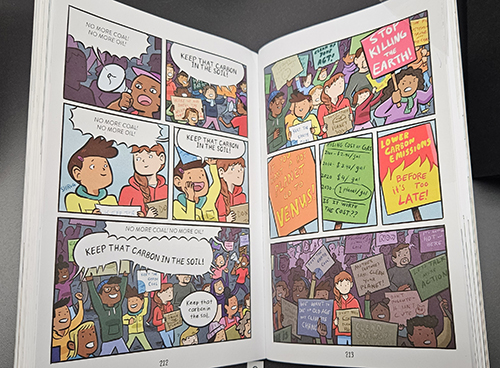
Contributing to the power of the exhibit are three large wallpaper murals, created by library graphic designer Dania Mukahhal.

The first wall contains the title of the exhibit and a collage of comics that depict social protests in comics. The second wall centers on quotes to explain the constitutional right to protest and to free speech.
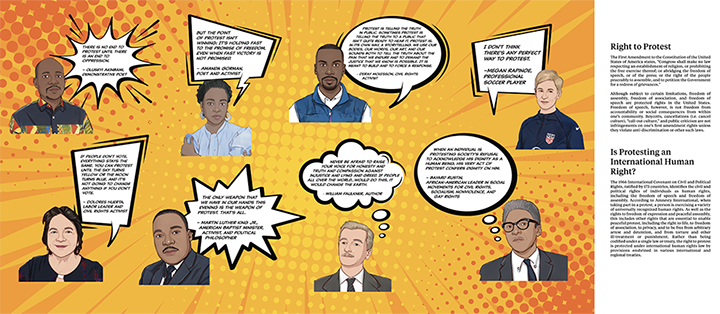
The final wall reminds visitors that voting can be an act of protest and encourages people to exercise their right to vote. Jackson notes that only about half of young adults vote and she hopes that this will encourage SDSU students to take a more active role in deciding their future via the ballot box. To further that goal, information sheets explaining how to register to vote will be available for visitors to take with them.
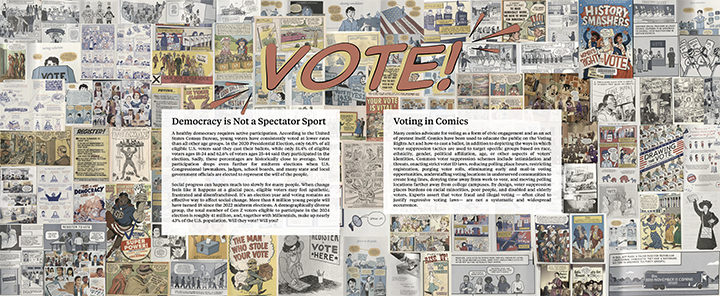
Library Dean Scott Walter notes that the new exhibit sits at the intersection of two major library initiatives that have grown rapidly since 2020 - the focus on diversity, equity, inclusion, and social justice across all library collections, and the commitment to strategic engagement with faculty colleagues in other colleges to invest in library collections, services, and programs that highlight and strengthen distinctive academic programs at SDSU, including Comics Studies.
Come explore how comics and graphic novels have depicted protests, both historical and fictional, and be encouraged to exercise your own right to protest. The cases are available now and the wallpaper will be added soon (follow @SDSUlibrary on social media for updates). The exhibit will remain in the library throughout 2024.
Everyone is especially invited to the exhibit grand opening on March 12 at 4 p.m. in the University Library.

